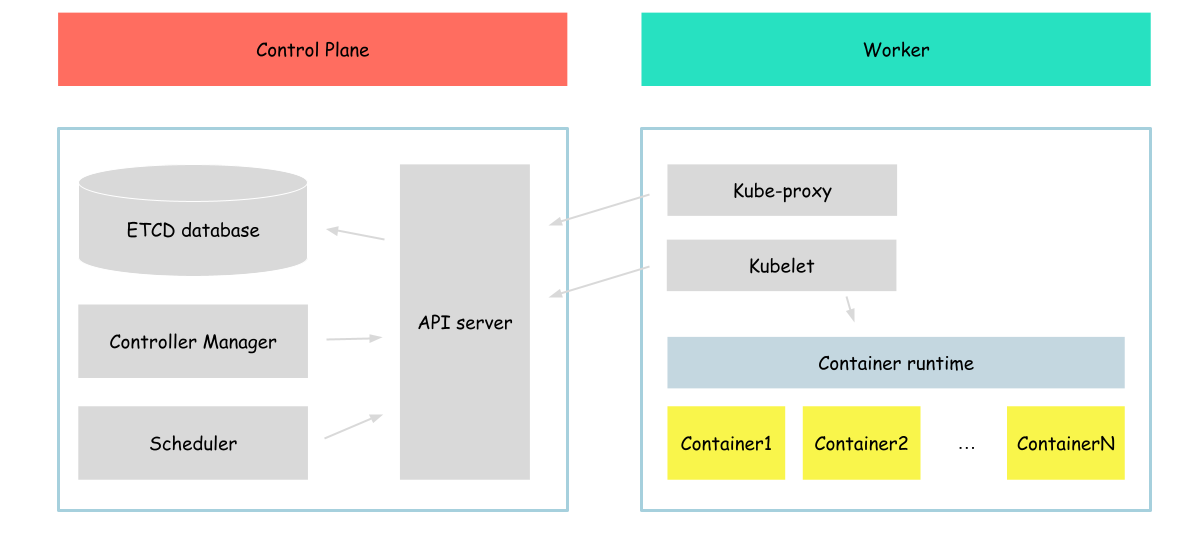7.8 KiB
Container runtime
In this section, we will focus on the container runtime.
runc
First of all, since Kubernetes is an orchestrator for containers, we would like to figure out how to run containers. A thing like OCI can help us here.
The OCI is a project under the Linux Foundation is aims to develop open industry standards for container formats and runtimes. The primary goal of OCI is to ensure container portability and interoperability across different platforms and container runtime implementations. The OCI has two main specifications, Runtime Specification (runtime-spec) and Image Specification (image-spec).
As we can see from the description - OCI is a standard that tells us what is a container image and how to run it.
But it is only a standard, obviously, there is some tool that implements this standard. And it is true, runc is a reference implementation of the OCI runtime specification.
So let's install it and run some container with the usage of runc
First of all we need to download runc binaries
wget -q --show-progress --https-only --timestamping \
https://github.com/opencontainers/runc/releases/download/v1.2.6/runc.amd64
After the download process is complete, we need to move runc binaries to proper folder
mv runc.amd64 runc \
&& chmod +x runc \
&& mv runc /usr/local/bin/
Now, as we have runc configured, we can run busybox container
mkdir -p busybox-container/rootfs/bin \
&& cd busybox-container/rootfs/bin \
&& wget https://www.busybox.net/downloads/binaries/1.31.0-defconfig-multiarch-musl/busybox-x86_64 \
&& chmod +x busybox-x86_64 \
&& ./busybox-x86_64 --install . \
&& cd ./../.. \
&& runc spec \
&& sed -i 's/"sh"/"echo","Hello from container runned by runc!"/' config.json
In this step, we downloaded the busybox image, unarchived it, and created the proper files, required by runc to run the container (including container configuration and files that will be accessible from the container). So, let's run our container
runc run busybox
Output:
Hello from container runned by runc!
Great, we created our first container in this tutorial. Now we will clean up our workspace.
cd .. \
&& rm -r busybox-container
containerd
As we can see, runc can run containers, but runc interface is something unknown for kubernetes.
There is another standard defined which is used by kubelet to communicate with container runtime - CRI
The CRI is a plugin interface which enables the kubelet to use a wide variety of container runtimes, without having a need to recompile the cluster components.
In this tutorial, we will use containerd as a tool which is compattible with CRI.
To deploy containerd, first of all, we need to download it.
wget https://github.com/containerd/containerd/releases/download/v2.0.4/containerd-2.0.4-linux-amd64.tar.gz
After download process complete, we need to unzip and move containerd binaries to proper folder
mkdir containerd \
&& tar -xvf containerd-2.0.4-linux-amd64.tar.gz -C containerd \
&& mv containerd/bin/* /bin/
In comparison to the runc, containerd is a service that works like a service that can be called by someone to run a container. It means that we need to run it before we can start communicating with it.
We will configure containerd as a service.
To do that, we need to create containerd configuration file
{
mkdir -p /etc/containerd/
cat << EOF | tee /etc/containerd/config.toml
[debug]
level = "debug"
[plugins]
[plugins.'io.containerd.cri.v1.images']
snapshotter = "native"
[plugins."io.containerd.cri.v1.runtime"]
[plugins."io.containerd.cri.v1.runtime".containerd]
default_runtime_name = "runc"
[plugins."io.containerd.cri.v1.runtime".containerd.runtimes]
[plugins."io.containerd.cri.v1.runtime".containerd.runtimes.runc]
runtime_type = "io.containerd.runc.v2"
snapshotter = "native"
[plugins."io.containerd.cri.v1.runtime".containerd.runtimes.runc.options]
BinaryName = "/usr/local/bin/runc"
EOF
}
As we can see, we configured containerd to use runc (we installed before) to run containers.
After configuration file create, we need to create containerd service
cat <<EOF | tee /etc/systemd/system/containerd.service
[Unit]
Description=containerd container runtime
Documentation=https://containerd.io
After=network.target
[Service]
ExecStart=/bin/containerd
Restart=always
RestartSec=5
Delegate=yes
KillMode=process
OOMScoreAdjust=-999
LimitNOFILE=1048576
LimitNPROC=infinity
LimitCORE=infinity
[Install]
WantedBy=multi-user.target
EOF
And now, run it
systemctl daemon-reload \
&& systemctl enable containerd \
&& systemctl start containerd
To ensure that our service successfully started, run
systemctl status containerd
Output:
● containerd.service - containerd container runtime
Loaded: loaded (/etc/systemd/system/containerd.service; enabled; vendor preset: enabled)
Active: active (running) since Sat 2023-04-15 21:04:43 UTC; 59s ago
Docs: https://containerd.io
Process: 1018 ExecStartPre=/sbin/modprobe overlay (code=exited, status=0/SUCCESS)
Main PID: 1031 (containerd)
Tasks: 9 (limit: 2275)
Memory: 22.0M
CGroup: /system.slice/containerd.service
└─1031 /bin/containerd
...
Now, we have containerd service running. It means that we can try to create some container.
To do that, we need the tool called ctr, which is distributed as part of containerd (which means that we already installed it during the installation of containerd).
First of all, we will pull busybox image
ctr images pull docker.io/library/busybox:latest
After the pull process is complete - check our image
ctr images ls
Output:
REF TYPE DIGEST SIZE PLATFORMS LABELS
docker.io/library/busybox:latest application/vnd.docker.distribution.manifest.list.v2+json sha256:b5d6fe0712636ceb7430189de28819e195e8966372edfc2d9409d79402a0dc16 2.5 MiB linux/386,linux/amd64,linux/arm/v5,linux/arm/v6,linux/arm/v7,linux/arm64/v8,linux/mips64le,linux/ppc64le,linux/riscv64,linux/s390x -
Now, let's start our container
ctr run --detach --snapshotter native docker.io/library/busybox:latest busybox-container sh -c 'while sleep 1; do echo "Hi"; done'
Output:
Hello from container runned by containerd!
As we can see we successfully started the container, now we can check its status
ctr containers ls
Output:
CONTAINER IMAGE RUNTIME
busybox-container docker.io/library/busybox:latest io.containerd.runc.v2
But there is no info about the status, we can see it by reviewing tasks
ctr task ls
Output:
TASK PID STATUS
busybox-container 2862580 RUNNING
As we can see our container is in the stopped state (because the command was successfully executed and the container stopped).
Now, let's clean up our workspace and go to the next section.
Stop running command
kill -9 $(ctr task ls | grep busybox | awk '{print $2}')
And remove the created container
ctr containers rm busybox-container
We can check that list of containers and tasks should be empty
ctr task ls \
&& ctr containers ls
We should receive an empty output
Next: Kubelet
